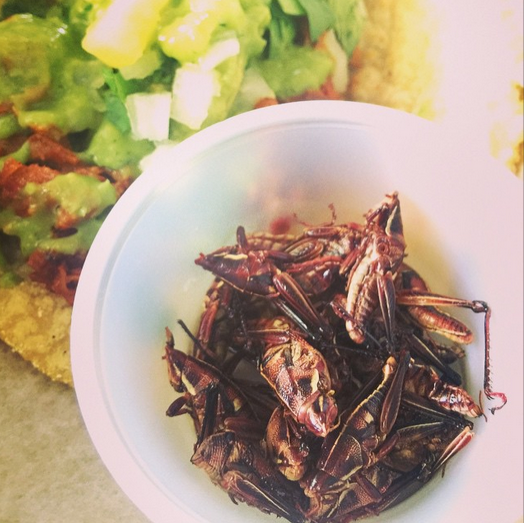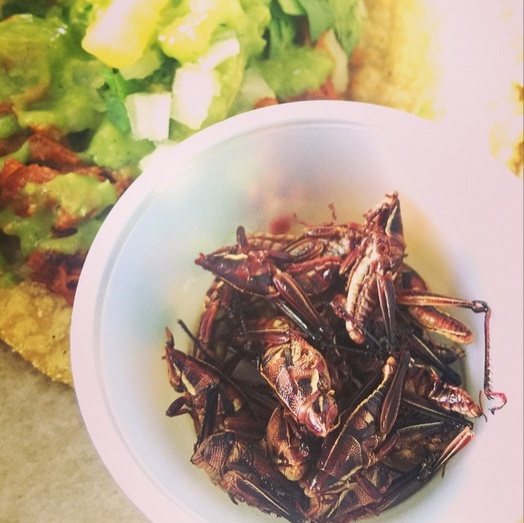The legs stay in your mouth for a good while. That’s probably the worst part.
I thought the eyes would be the hardest. The legs look like violin bows with hair. Or are they serrated like tiny, awful knives? The torso is unsettling. It’s a dull gray-brown suit of armor. Like a dirty infant lobster. But eating eyes is uncomfortably intimate. You can see death in eyes.
Wait, no. The torso is definitely unsettling. There are bones and guts in there, right? No food marketer ever bragged, “Now with 20% more bones and guts!”
I’m looking at a plastic ramekin full of crickets at Tacos Perla in San Diego. Actually, there are no guts. These crickets have been dehydrated, deep-fried, spritzed with lemon and dusted with chiles. And for $1.50, they are food. Add them to Perla’s tacos. Eat them straight and impress/disgust your friends. Taste the future.
Because, according to the Food and Agriculture Organization of the United Nations, this is the food of our past and our future. In 2013, the UN advocated that the world needs to start raising insects as food for both cattle and humans.
Sound gross? Well, you’re already eating bugs. The average American eats about two pounds of flies, maggots and other bugs each year.
The FDA’s Defect Levels Handbook explains it all. Frozen broccoli is legally allowed to have an average of 60 or more aphids per 100 grams. Your morning coffee? Allowed to contain up to 10 percent insect-infected or insect damaged beans. That craft beer? Hops can have 2,500 aphids per 10 grams. Peanut butter? Average of 30 or more insect fragments per 100 grams.
According to the FDA, the reason a certain amount of insects are allowed in commercial food is that it’s “economically impractical to grow, harvest or process raw products that are totally free of non-hazardous, naturally occurring, unavoidable defects.”
Granted, many foods contain far fewer insect parts than what is legally allowed. Still, it’s all but guaranteed you’re eating bugs.
And you’re not alone. Around 2 billion people eat insects across the world, according to the FAO. They’re staples in Africa, Asia and South America. The most consumed are beetles (31 percent), caterpillars (18 percent), bees, wasps and ants (14 percent), and grasshoppers, locusts and insects (13 percent).
It’s called entomophagy, or insectivory. They’ve been eaten since the dawn of time—by the entire world before the advent of hunting and farming. Raising them for food is called mini-livestock.
Why is it the future? Because world population is a real concern. We add about 200,000 people to this planet every single day, or 140 every minute, about 70 million people every year. We’re supposed to hit 9 billion people by 2050. That will require TWICE as much food as we need today. There aren’t enough burgers to feed everyone (and beef production is by far the worst agricultural action on the environment). Global wealth is increasing in countries like China and India, and they’re already out-bidding the United States for much of the “elite” proteins (just ask San Diego chefs, who each year are priced out of the local spiny lobster season because the Chinese are buying them at the docks).
Our seas are dangerously overfished. What we’re pulling out of the waters gets smaller and smaller every year. Some scientists have predicted the world’s fish could collapse during this century. Farmed fish is getting more and more effective and ecological, but it’s still not enough.
We need alternative sources of protein. Thanks to its affluence, America likely has a long while before it becomes an insect-hungry populace. But millions of Americans are food insecure. Insects are a real, economically and ecologically-friendly solution to this problem.
Insects are high in protein, good fats, iron, zinc and calcium (because you’re eating the entire body, including bones). Several studies have found insects a far more environmentally friendly source of protein than traditional livestock. Insects grow faster, take up less space, use less water, produce less ammonia. We currently use about 70% of agricultural land to raise livestock. Raising bugs uses far less acreage. Cattle takes 8 kg for 1 kg of beef, and only 40% is considered edible. It takes 1.7 kg of feed to produce one kg of insect meat and 80 percent is considered edible. Because insects are cold-blooded, they don’t use energy from feed to maintain body temperature. They can also feed on organic byproducts (animal and human waste), which reduces environmental contamination.
Some companies in the West have been making them into a powder (insect flour, cricket flour, cricket powder). Chapul was the first company to do cricket flour, selling protein bars full of the stuff. A company called Exo followed suit.
And it’s not that they should only be eaten by humans. Or maybe not even primarily. But especially as feed for traditional livestock, they’re a relatively untapped resource. Mealworms are already being farmed and used as pet food, zoos and recreational fishing.
As far as disease? It seems insects pose less threat to us than cows, pigs, and other livestock under the current production methods. Since there is a huge difference genetically between us and insects, that might also lessen the potential for disease like swine flu. It’s also something that could be done on a small scale, lowering the investment capital needed for small growers/ranchers (thus making it easier for craft crickets). It’s not as clear cut to implement this. Certain government rules and regulations need to be changed, and I won’t get into that here.
Crickets are the gateway bug. They are served at Typhoon in Santa Monica, at Sushi Mazi in Portland, and wold-famous chef Jose Andres serves them at Oyamel in D.C. In San Diego they’re sold at Perla and Escondido Mexican restaurant, El Tejate. On the wholesale side the American Cricket Ranch in San Diego is micro-ranching. San Diego Wax Worms is also raising bugs for food.
I like the future. But I can’t ignore that, as a Westerner, a ramekin full of salted crickets is the stuff of nightmares. Insects make people scream. Perla’s manager tries to get two employees to try them. Both decline, cast up-yours-I’ll-quit faces. Insects are the alien villains of horror movies. Our primal instinct is to squish them, squash them, exterminate them. Perhaps the worst of all is that they have become known in Western culture as harbingers of filth. They’re the squires of trash. Of shit!
If you have them in your kitchen, it’s a sign that you’re a pretty unclean human. It’s well-known that inside the decrepit hovel of any self-respecting serial killer, there are bugs everywhere.
In Guadalajara, Mexico, at a restaurant named La Tequila, I had a taco full of ant eggs (escamoles). Each egg, a millimeter in diameter, was covered in a gel-like white protein. I also had a taco full of agave larvae (gusanos de maguey). They looked like large, well-caramelized maggots, with hairy anuses on both ends. They were crunchy, yet let out a creaminess when bit. They were incredibly delicious, and visually and mentally disgusting.
When you put a cricket in your mouth, the first thing you feel are the legs. They feel like soft splinters. It’s simultaneously crunchy and soft, like a wet sunflower seed. Fitting, since there’s a grassy, dried-herbal flavor that tastes similar to a seedpod. At Perla, the body lets out a lemony juice. The legs crackle. As you chew, the legs and parts turn to shrapnel. I ate one 5 minutes ago and I can still feel leg parts in my mouth. Again, like a sunflower seed.
The taste is not offensive at all. More lemony than gross. But it’s definitely not what I’d call impressive. You might never crave this food in your life. The same restaurant that serves you crickets hires someone to kill their fruit flies.
But this blog on the Scientific American post makes a good point. When sushi first arrived in the US, Westerners thought eating raw fish was fairly gross. Now they pay big bucks for the opportunity.
Tacos Perla sells them because they’re a Mexican restaurant, and crickets are a delicacy in Oaxaca. And, sure, they might be doing it for the novelty as well. But whether their intentions are as noble or merely Fear Factor-ish doesn’t really matter. They’re doing their part to reduce stigma and even create some allure in trying to eat bugs.
So take a friend down to Perla. Taste the future. They serve beer, too.

PARTNER CONTENT
A side of crickets at Tacos Perla in North Park.

















